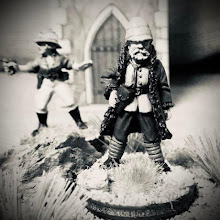All figures from Warlord Games.
From the BCW Project: British Civil Wars Project:
Though created a baronet in Janurary 1642, Sir John Gell supported Parliament on the outbreak of the English Civil War eight months later. He was commissioned by the Earl of Essex to secure Derbyshire for Parliament and made his base at Derby, where he raised infantry and cavalry regiments and a small train of artillery. As Derby had no castle or walls, Gell ordered the construction of extensive earthworks around the town.
Sir John Gell
Gell's enemy Lord Chesterfield seized early in 1643 and Gell joined Lord Brooke at the siege of Lichfield in March, taking over command of the Parliamentarian forces after Brooke was killed. When Lord Chesterfield surrendered Lichfield two days after Brooke's death, Gell sent him to London in chains.
Gell then joined forces with the Cheshire commander Sir William Brerteton with the intention of marching against Stafford. They clashed with the Midlands Royalists at the battle of Hopton Heath where the Earl of Northampton was killed. When the Earl's son refused to return the artillery captured at Hopton Heath or the money Gell had paid to embalm the body, the corpse was paraded through the streets of Derby before its burial at All Hallows Church.
In 1643, Gell was appointed commander of Parliament's forces in Derbyshire, Staffordshire and Warwickshire. Gell's troops became notorious for plundering and he used his dominance of the Derbyshire county committee to secure important appointments for his friends and relatives which led his opponents to complain to Parliament. Gell's loyalty came under suspicion when he failed to obey an order to bring his troops from the Midlands to join Fairfax on the Naseby campaign in 1645. At the siege of Tutbury Castle in 1646, he offered the Royalist defenders his own favorable terms for surrender in opposition to those offered by his fellow commander Brereton.
In 1648, Gell attempted to secure a pardon from Charles I during his imprisonment at Carisbrooke Castle by offering to lend him £900 in gold. In 1650, he was found guilty of plotting against the Commonwealth and imprisoned in the Tower of London until 1652, after which he lived quietly in London. At the Restoration, Charles II pardoned him for his role in the civil war and granted him a position at court, where he remained until his death in October 1671.







Fabulous looking Pike & Shotte troops, Neil. Love the basing too - nice work getting the pikemen positioned.
ReplyDeleteDean - Thanks. I was trying to get the "animation" of the attack without exposing the pikes to actually getting in the way!
DeleteVery nice indeed Neil!
ReplyDeleteThis comment has been removed by the author.
DeleteMichael - Thanks! I had a lot of fun with this unit especially with the experimentation with the washes in getting different coat colors with the gray.
DeleteNice work. What rules are they based for? Are they 50mm squares?
ReplyDeleteKen - The bases are 60mm squares and are based for Victory Without Quarter. If you haven't tried them I recommend them whole heartedly. There are available for free on the internet and to me reflect the feel of the warfare of the period without getting bogged down in lots of charts and record keeping.
DeleteBeautiful troops and nice background...great job!
ReplyDelete